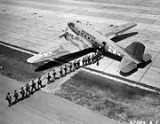
C-47 Skytrain
Encyclopedia
The Douglas
C-47 Skytrain or Dakota is a military transport aircraft that was developed from the Douglas DC-3
airliner. It was used extensively by the Allies
during World War II
and remained in front line operations through the 1950s with a few remaining in operation to this day.
During World War II, the armed forces of many countries used the C-47 and modified DC-3s for the transport of troops, cargo and wounded. The US Naval designation was R4D. Over 10,000 aircraft were produced in Long Beach
and Santa Monica, California
and Oklahoma City, Oklahoma
. The Oklahoma City plant produced 5,354 C-47s from March 1943 until August 1945.

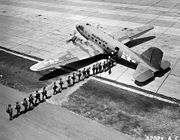
, and with increased speed to compete with newer airliners. The new model, the DC-3S or "Super DC-3", was 39 in (0.99 m) longer, allowing 30 passengers to be carried. It also had larger tail surfaces and new outer wings with a greater sweep back at the trailing edge to accommodate a rearward shift in the center of gravity. More powerful engines, either 1,475 hp (1,100 kW) Wright R-1820
Cyclones or 2,000 hp (1,490 kW) Pratt & Whitney R-2000
s incorporated into larger engine nacelles, were installed along with shorter, jet ejection-type exhaust stacks. Minor changes included wheel well doors and a partially retractable tail wheel along with flush rivets and low drag antennas, that all contributed to a top speed of 250 mph. With over 75% of the original DC-3/C-47 configuration changed, the modified design ended up virtually as a new aircraft. The first DC-3S made its maiden flight on 23 June 1949.
Although the changes fully met the new FAR 4B airworthiness requirements, and significantly improved performance, there was little interest from commercial operators in the DC-3S, which was too-expensive for the smaller operators who were its main target, with only three being sold to Capital Airlines
. The US Navy, however, had 100 of its R4D aircraft modified to Super DC-3 standard as the R4D-8, these later being redesignated C-117D.
campaigns, in particular those at Guadalcanal and in the jungles of New Guinea
and Burma
where the C-47 (and its naval version, the R4D) made it possible for Allied troops to counter the mobility of the light-traveling Japanese army. Additionally, C-47s were used to airlift supplies to the embattled American forces during the Battle of Bastogne
. But possibly its most influential role in military aviation was flying "The Hump
" from India
into China
. The expertise gained flying "The Hump
" would later be used in the Berlin Airlift, in which the C-47 would play a major role, until being replaced by the C-54
.
In Europe, the C-47 and a specialized paratroop
variant, the C-53 Skytrooper, were used in vast numbers in the later stages of the war, particularly to tow glider
s and drop paratroops. In the Pacific
, with careful use of the island landing strips of the Pacific Ocean, C-47s were even used for ferrying soldiers serving in the Pacific theater back to the United States.
C-47s in British and Commonwealth service took the name Dakota, from the acronym "DACoTA" for Douglas Aircraft Company Transport Aircraft. The C-47 also earned the informal nickname Gooney Bird
in the European theater of operations.
The USAF
Strategic Air Command
had C-47 Skytrains in service from 1946 through 1967.
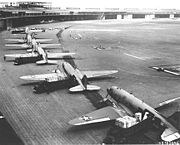 The Pakistan Air Force
The Pakistan Air Force
used C-47 Dakota cargo planes which it used to transport supplies to the Pakistan Army
soldiers fighting in the Indo-Pakistan War of 1947 against India.
Several C-47 variations were used in the Vietnam War
by the United States Air Force, including three advanced electronic warfare variations which were sometimes called "Electric Gooneys" designated EC-47N, EC-47P, or EC-47Qs depending on the engine used. EC-47s were also operated by the Vietnamese, Laotian and Cambodian Air Forces. A gunship variation, utilizing three 7.62mm miniguns, designated AC-47 "Spooky"
often nicknamed "Puff the Magic Dragon" was also deployed.
The Royal Canadian Air Force
and later, the Canadian Armed Forces employed the C-47 for transportation, navigation and radar training, and search & rescue operations from the 1940s to the 1980s.
After World War II thousands of surplus C-47s were converted to civil airline use, some remaining in operation in 2010.
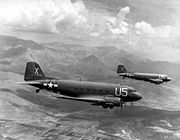


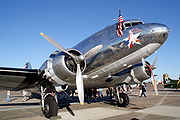
C-47
C-53 Skytrooper
C-117A Skytrooper
YC-129
CC-129
XCG-17
R4D-1 Skytrain
 Dakota I
Dakota I
Dakota III
Dakota IV
.jpg)

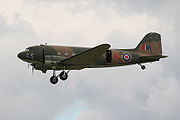
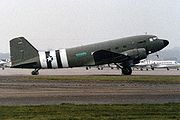
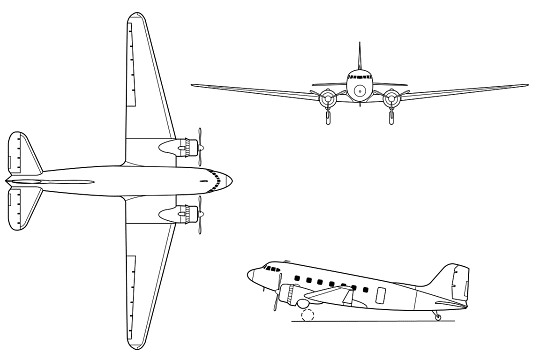
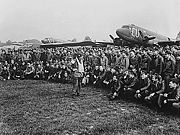
Douglas Aircraft Company
The Douglas Aircraft Company was an American aerospace manufacturer, based in Long Beach, California. It was founded in 1921 by Donald Wills Douglas, Sr. and later merged with McDonnell Aircraft in 1967 to form McDonnell Douglas...
C-47 Skytrain or Dakota is a military transport aircraft that was developed from the Douglas DC-3
Douglas DC-3
The Douglas DC-3 is an American fixed-wing propeller-driven aircraft whose speed and range revolutionized air transport in the 1930s and 1940s. Its lasting impact on the airline industry and World War II makes it one of the most significant transport aircraft ever made...
airliner. It was used extensively by the Allies
Allies of World War II
The Allies of World War II were the countries that opposed the Axis powers during the Second World War . Former Axis states contributing to the Allied victory are not considered Allied states...
during World War II
World War II
World War II, or the Second World War , was a global conflict lasting from 1939 to 1945, involving most of the world's nations—including all of the great powers—eventually forming two opposing military alliances: the Allies and the Axis...
and remained in front line operations through the 1950s with a few remaining in operation to this day.
Design and development
The C-47 differed from the civilian DC-3 in numerous modifications that included being fitted with a cargo door and strengthened floor.During World War II, the armed forces of many countries used the C-47 and modified DC-3s for the transport of troops, cargo and wounded. The US Naval designation was R4D. Over 10,000 aircraft were produced in Long Beach
Long Beach, California
Long Beach is a city situated in Los Angeles County in Southern California, on the Pacific coast of the United States. The city is the 36th-largest city in the nation and the seventh-largest in California. As of 2010, its population was 462,257...
and Santa Monica, California
Santa Monica, California
Santa Monica is a beachfront city in western Los Angeles County, California, US. Situated on Santa Monica Bay, it is surrounded on three sides by the city of Los Angeles — Pacific Palisades on the northwest, Brentwood on the north, West Los Angeles on the northeast, Mar Vista on the east, and...
and Oklahoma City, Oklahoma
Oklahoma City, Oklahoma
Oklahoma City is the capital and the largest city in the state of Oklahoma. The county seat of Oklahoma County, the city ranks 31st among United States cities in population. The city's population, from the 2010 census, was 579,999, with a metro-area population of 1,252,987 . In 2010, the Oklahoma...
. The Oklahoma City plant produced 5,354 C-47s from March 1943 until August 1945.


Super DC-3 (R4D-8)
In response to proposed changes to the airworthiness requirements that would limit the continuing use of the large numbers of DC-3s and surplus C-47s in commercial use in the United States, Douglas offered a late 1940s conversion of the DC-3 modified to improve takeoff and single-engined performance to meet the new Civil Air RegulationsFederal Aviation Regulations
The Federal Aviation Regulations, or FARs, are rules prescribed by the Federal Aviation Administration governing all aviation activities in the United States. The FARs are part of Title 14 of the Code of Federal Regulations...
, and with increased speed to compete with newer airliners. The new model, the DC-3S or "Super DC-3", was 39 in (0.99 m) longer, allowing 30 passengers to be carried. It also had larger tail surfaces and new outer wings with a greater sweep back at the trailing edge to accommodate a rearward shift in the center of gravity. More powerful engines, either 1,475 hp (1,100 kW) Wright R-1820
Wright R-1820
|-See also:-References:* Bridgman, L, Jane's Fighting Aircraft of World War II. Crescent. ISBN 0-517-67964-7* Eden, Paul & Soph Moeng, The Complete Encyclopedia of World Aircraft. Amber Books Ltd. Bradley's Close, 74-77 White Lion Street, London, NI 9PF, 2002, ISBN 0-7607-3432-1), 1152...
Cyclones or 2,000 hp (1,490 kW) Pratt & Whitney R-2000
Pratt & Whitney R-2000
|-See also:-Bibliography:...
s incorporated into larger engine nacelles, were installed along with shorter, jet ejection-type exhaust stacks. Minor changes included wheel well doors and a partially retractable tail wheel along with flush rivets and low drag antennas, that all contributed to a top speed of 250 mph. With over 75% of the original DC-3/C-47 configuration changed, the modified design ended up virtually as a new aircraft. The first DC-3S made its maiden flight on 23 June 1949.
Although the changes fully met the new FAR 4B airworthiness requirements, and significantly improved performance, there was little interest from commercial operators in the DC-3S, which was too-expensive for the smaller operators who were its main target, with only three being sold to Capital Airlines
Capital Airlines
Capital Airlines was an airline serving the eastern United States that merged into United Airlines in 1961. Its primary hubs were National Airport near Washington, DC, and Allegheny County Airport near Pittsburgh. In the 1950s it was the largest US domestic carrier after the Big Four . Its...
. The US Navy, however, had 100 of its R4D aircraft modified to Super DC-3 standard as the R4D-8, these later being redesignated C-117D.
Operational history
The C-47 was vital to the success of many AlliedAllies of World War II
The Allies of World War II were the countries that opposed the Axis powers during the Second World War . Former Axis states contributing to the Allied victory are not considered Allied states...
campaigns, in particular those at Guadalcanal and in the jungles of New Guinea
New Guinea
New Guinea is the world's second largest island, after Greenland, covering a land area of 786,000 km2. Located in the southwest Pacific Ocean, it lies geographically to the east of the Malay Archipelago, with which it is sometimes included as part of a greater Indo-Australian Archipelago...
and Burma
Burma Campaign
The Burma Campaign in the South-East Asian Theatre of World War II was fought primarily between British Commonwealth, Chinese and United States forces against the forces of the Empire of Japan, Thailand, and the Indian National Army. British Commonwealth land forces were drawn primarily from...
where the C-47 (and its naval version, the R4D) made it possible for Allied troops to counter the mobility of the light-traveling Japanese army. Additionally, C-47s were used to airlift supplies to the embattled American forces during the Battle of Bastogne
Battle of Bastogne
The Siege of Bastogne was an engagement between American and German forces at the Belgian town of Bastogne, as part of the larger Battle of the Bulge. The goal of the German offensive was the harbor at Antwerp. In order to reach it before the Allies could regroup and bring their superior air power...
. But possibly its most influential role in military aviation was flying "The Hump
The Hump
The Hump was the name given by Allied pilots in the Second World War to the eastern end of the Himalayan Mountains over which they flew military transport aircraft from India to China to resupply the Chinese war effort of Chiang Kai-shek and the units of the United States Army Air Forces based in...
" from India
India
India , officially the Republic of India , is a country in South Asia. It is the seventh-largest country by geographical area, the second-most populous country with over 1.2 billion people, and the most populous democracy in the world...
into China
China
Chinese civilization may refer to:* China for more general discussion of the country.* Chinese culture* Greater China, the transnational community of ethnic Chinese.* History of China* Sinosphere, the area historically affected by Chinese culture...
. The expertise gained flying "The Hump
The Hump
The Hump was the name given by Allied pilots in the Second World War to the eastern end of the Himalayan Mountains over which they flew military transport aircraft from India to China to resupply the Chinese war effort of Chiang Kai-shek and the units of the United States Army Air Forces based in...
" would later be used in the Berlin Airlift, in which the C-47 would play a major role, until being replaced by the C-54
C-54 Skymaster
The Douglas C-54 Skymaster was a four-engined transport aircraft used by the United States Army Air Forces and British forces in World War II and the Korean War. Besides transport of cargo, it also carried presidents, British heads of government, and military staff...
.
In Europe, the C-47 and a specialized paratroop
Paratrooper
Paratroopers are soldiers trained in parachuting and generally operate as part of an airborne force.Paratroopers are used for tactical advantage as they can be inserted into the battlefield from the air, thereby allowing them to be positioned in areas not accessible by land...
variant, the C-53 Skytrooper, were used in vast numbers in the later stages of the war, particularly to tow glider
Military glider
Military gliders have been used by the military of various countries for carrying troops and heavy equipment to a combat zone, mainly during the Second World War. These engineless aircraft were towed into the air and most of the way to their target by military transport planes, e.g...
s and drop paratroops. In the Pacific
Pacific War
The Pacific War, also sometimes called the Asia-Pacific War refers broadly to the parts of World War II that took place in the Pacific Ocean, its islands, and in East Asia, then called the Far East...
, with careful use of the island landing strips of the Pacific Ocean, C-47s were even used for ferrying soldiers serving in the Pacific theater back to the United States.
C-47s in British and Commonwealth service took the name Dakota, from the acronym "DACoTA" for Douglas Aircraft Company Transport Aircraft. The C-47 also earned the informal nickname Gooney Bird
Albatross
Albatrosses, of the biological family Diomedeidae, are large seabirds allied to the procellariids, storm-petrels and diving-petrels in the order Procellariiformes . They range widely in the Southern Ocean and the North Pacific...
in the European theater of operations.
The USAF
United States Air Force
The United States Air Force is the aerial warfare service branch of the United States Armed Forces and one of the American uniformed services. Initially part of the United States Army, the USAF was formed as a separate branch of the military on September 18, 1947 under the National Security Act of...
Strategic Air Command
Strategic Air Command
The Strategic Air Command was both a Major Command of the United States Air Force and a "specified command" of the United States Department of Defense. SAC was the operational establishment in charge of America's land-based strategic bomber aircraft and land-based intercontinental ballistic...
had C-47 Skytrains in service from 1946 through 1967.

Pakistan Air Force
The Pakistan Air Force is the leading air arm of the Pakistan Armed Forces and is primarily tasked with the aerial defence of Pakistan with a secondary role of providing air support to the Pakistan Army and the Pakistan Navy. The PAF also has a tertiary role of providing strategic air transport...
used C-47 Dakota cargo planes which it used to transport supplies to the Pakistan Army
Pakistan Army
The Pakistan Army is the branch of the Pakistani Armed Forces responsible for land-based military operations. The Pakistan Army came into existence after the Partition of India and the resulting independence of Pakistan in 1947. It is currently headed by General Ashfaq Parvez Kayani. The Pakistan...
soldiers fighting in the Indo-Pakistan War of 1947 against India.
Several C-47 variations were used in the Vietnam War
Vietnam War
The Vietnam War was a Cold War-era military conflict that occurred in Vietnam, Laos, and Cambodia from 1 November 1955 to the fall of Saigon on 30 April 1975. This war followed the First Indochina War and was fought between North Vietnam, supported by its communist allies, and the government of...
by the United States Air Force, including three advanced electronic warfare variations which were sometimes called "Electric Gooneys" designated EC-47N, EC-47P, or EC-47Qs depending on the engine used. EC-47s were also operated by the Vietnamese, Laotian and Cambodian Air Forces. A gunship variation, utilizing three 7.62mm miniguns, designated AC-47 "Spooky"
AC-47 Spooky
The Douglas AC-47 Spooky was the first in a series of gunships developed by the United States Air Force during the Vietnam War...
often nicknamed "Puff the Magic Dragon" was also deployed.
The Royal Canadian Air Force
Royal Canadian Air Force
The history of the Royal Canadian Air Force begins in 1920, when the air force was created as the Canadian Air Force . In 1924 the CAF was renamed the Royal Canadian Air Force and granted royal sanction by King George V. The RCAF existed as an independent service until 1968...
and later, the Canadian Armed Forces employed the C-47 for transportation, navigation and radar training, and search & rescue operations from the 1940s to the 1980s.
After World War II thousands of surplus C-47s were converted to civil airline use, some remaining in operation in 2010.
Variants




C-47
- Initial military version of the DC-3 with seats for 27 troops, 965 built including 12 to the United States Navy as R4D-1,
- C-47A
- :C-47 with a 24-volt electrical system, 5,254 built including USN aircraft designated R4D-5
- RC-47A
- : equipped for photographic reconnaissance and ELINT missions
- SC-47A
- :C-47A equipped for Search Air Rescue; redesignated HC-47A in 1962
- VC-47A
- :C-47A equipped for VIP transport role
- C-47B
- :Powered by R-1830-90 engines with superchargers and extra fuel capacity to cover the ChinaChinaChinese civilization may refer to:* China for more general discussion of the country.* Chinese culture* Greater China, the transnational community of ethnic Chinese.* History of China* Sinosphere, the area historically affected by Chinese culture...
-Burma-IndiaIndiaIndia , officially the Republic of India , is a country in South Asia. It is the seventh-largest country by geographical area, the second-most populous country with over 1.2 billion people, and the most populous democracy in the world...
routes, 3,364 built - VC-47B
- :C-47B equipped for VIP transport role
- XC-47C
- :C-47 tested with Edo Model 78 floats for possible use as a seaplane
- C-47D
- C-47B with superchargers removed after the war
- AC-47DAC-47 SpookyThe Douglas AC-47 Spooky was the first in a series of gunships developed by the United States Air Force during the Vietnam War...
- Gunship aircraft with three side-firing .30 in (7.62 mm) MinigunMinigunThe Minigun is a 7.62 mm, multi-barrel heavy machine gun with a high rate of fire , employing Gatling-style rotating barrels with an external power source...
machine guns - EC-47D
- :C-47D with equipment for the Airborne Early Warning role; prior to 1962 was designated AC-47D
- NC-47D
- :C-47D modified for test role
- RC-47D
- :C-47D equipped for photographic reconnaissance and ELINT missions
- SC-47D
- :C-47D equipped for Search Air Rescue; redesignated HC-47D in 1962
- VC-47D
- :C-47D equipped for VIP transport role
- C-47E
- Modified cargo variant with space for 27–28 passengers or 18–24 litters
- C-47F
- :YC-129 re-designated, Super DC-3 prototype for evaluation by USAF later passed to USN as XR4D-8
- C-47L/M
- :C-47H/Js equipped for the support of American Legation United States Naval Attache (ALUSNA) and Military Assistance Advisory Group (MAAG) missions
- EC-47N/P/Q
- :C-47A and D aircraft modified for ELINT/ARDF mission. N and P differ in radio bands covered, while Q replaces analog equipment found on the N and P with a digital suite, redesigned antenna equipment and uprated engines
- C-47R
- :One C-47M modified for high altitude work, specifically for missions in Ecuador
- C-47TBasler BT-67-See also:-External links:* * * * *...
- :Designation applied to aircraft modified to a Basler BT-67Basler BT-67-See also:-External links:* * * * *...
standard - C-47TP Turbo Dakota
- :Refit with modern turbopropTurbopropA turboprop engine is a type of turbine engine which drives an aircraft propeller using a reduction gear.The gas turbine is designed specifically for this application, with almost all of its output being used to drive the propeller...
engines and fuselage stretch for the South African Air ForceSouth African Air ForceThe South African Air Force is the air force of South Africa, with headquarters in Pretoria. It is the world's second oldest independent air force, and its motto is Per Aspera Ad Astra...
C-53 Skytrooper
- Troop transport version of the C-47.
- XC-53A Skytrooper
- :One aircraft with full-span slotted flaps and hot-air leading edge deicing
- C-53B Skytrooper
- :Winterised version of C-53 with extra fuel capacity and separate navigator's station, eight built
- C-53C Skytrooper
- :C-53 with larger port-side door, 17 built
- C-53D Skytrooper
- :C-53C with 24V DC electrical system, 159 built
C-117A Skytrooper
- C-47B with 24-seat airline-type interior for staff transport use, 16 built.
- VC-117A
- :Three redesignated C-117s used in the VIP role
- SC-117A
- :One C-117C converted for air-sea rescue
- C-117B/VC-117B
- :High-altitude superchargers removed, one built and conversions from C-117As all later VC-117B
- C-117D
- :USN/USMC R4D-8 redesignate
- LC-117D
- :USN/USMC R4D-8L redesignate
- TC-117D
- :USN/USMC R4D-8T redesignate
- VC-117D
- :USN R4D-8Z redesignate
YC-129
- Super DC-3 prototype for evaluation by USAF redesignated C-47F and later passed to USN as XR4D-8.
CC-129
- Canadian Forces designation for the C-47 (post-1970).
XCG-17
Douglas XCG-17
The Douglas XCG-17 was an American assault glider, developed by the conversion of a C-47 Skytrain twin-engine transport during World War II. Although the XCG-17 was successful in testing, the requirement for such a large glider had passed, and no further examples of the type were built; one...
- One C-47 tested as a 40-seat troop glider with engines removed and faired over.
R4D-1 Skytrain
- USN/USMC version of the C-47.
- R4D-3
- :Twenty C-53Cs transferred to USN
- R4D-5
- :C-47A variant 24-volt electrical system replacing the 12-volt of the C-47; redesignated C-47H in 1962, 238 transferred from USAF
- R4D-5L
- :R4D-5 for use in Antarctica. Redesignated LC-47H in 1962
- R4D-5Q
- :R4D-5 for use as special ECM trainer. Redesignated EC-47H in 1962
- R4D-5R
- :R4D-5 for use as a personnel transport for 21 passengers and as a trainer aircraft; redesignated TC-47H in 1962
- R4D-5S
- :R4D-5 for use as a special ASW trainer; redesignated SC-47H in 1962
- R4D-5Z
- :R4D-5 for use as a VIP transport; redesignated VC-47H in 1962
- R4D-6
- :157 C-47Bs transferred to USN; redesignated C-47J in 1962
- R4D-6L, Q, R, S, and Z
- :Variants as the R4D-5 series; redesignated LC-47J, EC-47J, TC-47J, SC-47J, and VC-47J respectively in 1962
- R4D-7
- :44 TC-47Bs transferred from USAF for use as a navigational trainer; redesignated TC-47K in 1962
- R4D-8
- :R4D-5 and R4D-6 aircraft fitted with modified wings and re-designed tail surfaces; redesignated C-117D in 1962
- R4D-8L
- :R4D-8 converted for Antarctic use, redesignated LC-117D in 1962
- R4D-8T
- :R4D-8 converted as crew trainers, redesignated TC-117D in 1962
- R4D-8Z
- :R4D-8 converted as a staff transport, redesignated VC-117D in 1962
RAF designations

- RAF designation for the C-47 and R4D-1
Dakota III
- RAF designation for the C-47A.
Dakota IV
- RAF designation for the C-47B.
Operators
.jpg)



Accidents and incidents
Specifications (C-47B-DK)

See also


